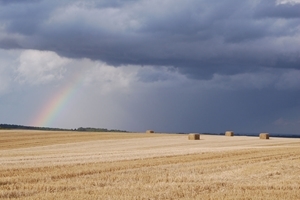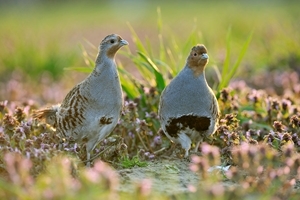 While unseasonal weather has played havoc with this year’s harvest, we should also stop to think of its impact on wildlife, according to experts at the Game & Wildlife Conservation Trust (GWCT). The grey partridge, known by conservationists as the ‘barometer of the countryside’, is one species likely to be affected by a dry spring and a dull, wet July and August. The Partridge Count Scheme wants help to find out just how much of an impact the summer’s weather has had on our wild grey partridge population.
While unseasonal weather has played havoc with this year’s harvest, we should also stop to think of its impact on wildlife, according to experts at the Game & Wildlife Conservation Trust (GWCT). The grey partridge, known by conservationists as the ‘barometer of the countryside’, is one species likely to be affected by a dry spring and a dull, wet July and August. The Partridge Count Scheme wants help to find out just how much of an impact the summer’s weather has had on our wild grey partridge population.
Following the summer of 2012, grey partridge numbers suffered a sharp decline following the wettest summer in recent English history, again after a remarkably dry spring. Whilst 2021 hasn’t seen the same extremes of that year, the GWCT is urging farmers to look out for their partridges and report their findings.
“As thunderstorms struck southern England in July, grey partridge chicks would have been desperately sheltering from the rain,” says Dr Julie Ewald, Head of GIS at the GWCT. “This unseasonal weather makes good farmland habitat even more important, reducing the distance chicks need to forage and the risk of predation by foxes and other predators.”
Julie and her GWCT colleagues are urging farmers to sign up for the Partridge Count Scheme, a voluntary initiative that, since 1933, has been collecting information on the abundance and breeding success of grey partridges. “We can’t control the weather, but individuals on the ground can make a real difference to the future of our partridges by implementing key habitats, management, and monitoring the effect”, adds Julie. “Success should be reflected in subsequent counts, further encouraging landowners and managers to strengthen their efforts. The count also provides a meaningful contribution to our understanding of what’s happening to wild grey partridges across the countryside.”
Partridges are particularly vulnerable to predation as they nest, forage and roost on the ground, with nesting females particularly vulnerable. The impact of extreme weather events, particularly rainfall, can make foraging incredibly dangerous for the chicks. Partridge chicks forage for insects to feed on within the first few days after hatching and, as a result, are extremely vulnerable if they have to travel further to find enough food.
What can you do to help?
 Any farmers, landowners, land managers, or gamekeepers who want to help conserve grey partridge on their land are invited to join the Partridge Count Scheme, take part by counting partridges and submit their findings to the GWCT’s national database. There are no restrictions on how few partridges you need to have, nor do you have to be interested in them as a quarry species. As well as farms and shoots, the scheme also has the involvement of nature reserves, land-based higher education colleges and golf links. For more information about the count simply visit www.gwct.org.uk/pcs.
Any farmers, landowners, land managers, or gamekeepers who want to help conserve grey partridge on their land are invited to join the Partridge Count Scheme, take part by counting partridges and submit their findings to the GWCT’s national database. There are no restrictions on how few partridges you need to have, nor do you have to be interested in them as a quarry species. As well as farms and shoots, the scheme also has the involvement of nature reserves, land-based higher education colleges and golf links. For more information about the count simply visit www.gwct.org.uk/pcs.
The GWCT has produced plenty of guidance on how to support grey partridges on your farm, based on their research and on experience gained through running the Partridge Count Scheme, including:
- Constructing beetle banks across large arable fields to increase the amount of nesting cover.
- Managing the grass beside hedgerows so that there is always old dead grass from the previous year available for nesting.
- Keeping your hedges trimmed (preferably after the berry crop has finished) to under six feet in height to avoid them being used as lookout posts by avian predators.
- Making wise use of field corners to create grassy nesting cover next to cereal crops with conservation headlands, or unharvested cereal headlands.
Notes to editors
The Game & Wildlife Conservation Trust – providing research-led conservation for a thriving countryside. The GWCT is an independent wildlife conservation charity which has carried out scientific research into Britain’s game and wildlife since the 1930s. We advise farmers and landowners on improving wildlife habitats. We employ more than 60 post-doctoral scientists and other research staff with expertise in areas such as birds, insects, mammals, farming, fish and statistics. We undertake our own research as well as projects funded by contract and grant-aid from government and private bodies.
For information, contact:
Eleanor Williams
Telephone: 07592 025476
Email: press@gwct.org.uk